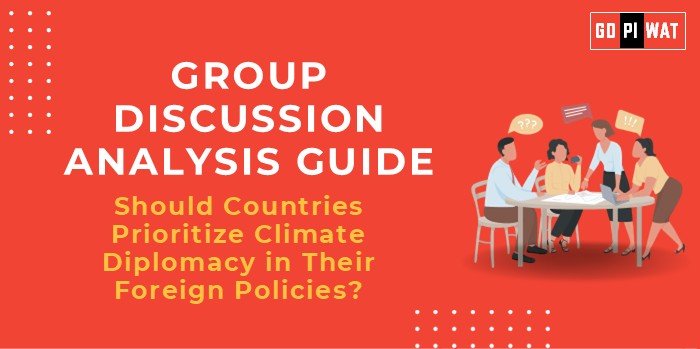📋 Group Discussion Analysis Guide
🌍 Should Countries Prioritize Climate Diplomacy in Their Foreign Policies?
🌟 Introduction to the Topic
📖 Opening Context: “As climate change emerges as a critical global challenge, the integration of climate diplomacy into foreign policy is no longer optional but imperative.”
📜 Topic Background: Climate diplomacy involves leveraging international relationships to address climate change, focusing on cooperation for emission reductions, technology transfer, and financing green initiatives. The Paris Agreement (2015) catalyzed this shift, urging nations to incorporate climate agendas into international collaborations.
📊 Quick Facts and Key Statistics
- 🌍 Global Emissions: The top 10 emitters contribute over 68% of global CO₂ emissions.
- 💰 Economic Impact: Climate disasters cost $313 billion globally in 2022 (World Bank).
- 🔋 Renewable Energy Growth: Investments surpassed $1.3 trillion in 2023.
- 🛤️ Climate Refugees: 21.5 million displaced annually due to climate-related disasters (UNHCR).
- 📉 Funding Gap: $2.4 trillion annually required to meet climate targets (IPCC).
👥 Stakeholders and Their Roles
- 🏛️ Governments: Formulate and implement climate policies in foreign relations.
- 🌐 International Organizations: Facilitate frameworks like the UNFCCC and Paris Agreement.
- 🏢 Private Sector: Drive green innovation and financing.
- 🌱 NGOs and Civil Societies: Advocate for policy changes and grassroots mobilization.
- 📊 Academic and Research Bodies: Offer data-driven insights and solutions.
🏆 Achievements and Challenges
🌟 Achievements:
- 📜 Paris Agreement commitments by 194 nations to reduce emissions.
- 💡 Development of global green technology collaboration platforms.
- ☀️ Renewable energy agreements, e.g., the International Solar Alliance (ISA).
⚠️ Challenges:
- 💰 Funding gaps in climate adaptation for developing countries.
- 🤝 Diverging interests between developed and developing nations.
- 📏 Inadequate enforcement of international agreements.
🌍 Global Comparisons:
- 🇪🇺 Success: The EU’s Green Deal prioritizes climate in trade negotiations.
- 🇺🇸 Challenges: The U.S. Inflation Reduction Act faced global criticism for protectionism.
📚 Case Studies:
- 🇮🇳🤝🇳🇴 India-Norway Green Partnership: A model of technology transfer for renewable energy.
- 🇨🇳 China’s Belt and Road Green Initiative: Mixed outcomes with criticism of greenwashing.
✨ Structured Arguments for Discussion
- 💬 Supporting Stance: “Integrating climate diplomacy ensures sustainable development and global cooperation.”
- ⚖️ Opposing Stance: “Over-prioritizing climate diplomacy can overshadow urgent geopolitical issues like security and trade.”
- 🔄 Balanced Perspective: “While crucial, climate diplomacy should align with a country’s immediate strategic interests.”
🎯 Effective Discussion Approaches
📖 Opening Approaches:
- Start with alarming statistics on climate disasters.
- Highlight a successful climate initiative as inspiration.
🔄 Counter-Argument Handling:
- “While economic priorities are valid, integrating climate goals can unlock green trade opportunities and innovation.”
📈 Strategic Analysis of Strengths and Weaknesses
- 💪 Strengths: Enhances global cooperation, opens avenues for green technology leadership.
- ⚠️ Weaknesses: Limited funding, conflicting national interests.
- 💡 Opportunities: Access to green financing, leadership in global climate governance.
- 🚨 Threats: Economic competition, geopolitical disputes.
📚 Connecting with B-School Applications
- 🌟 Real-World Applications: Climate diplomacy intersects with global finance, operations, and CSR initiatives.
- 💬 Sample Interview Questions:
- “How can climate diplomacy influence global trade policies?”
- “Discuss the role of technology transfer in climate diplomacy.”
- 📖 Insights for Students:
- Explore projects on green finance, public-private climate partnerships, and risk mitigation strategies.


